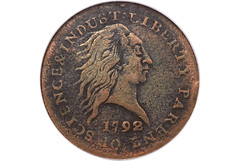
PREV ARTICLE
NEXT ARTICLE
FULL ISSUE
PREV FULL ISSUE
HERITAGE TO AUCTION 1792 FUSIBLE ALLOY CENT
Heritage is auctioning one of the great rarities of U.S. numismatics - the 1792 Fusible Alloy Cent.
I don't often care to repeat press release hype, but I have to agree that "For a determined collector, it's a once in a lifetime opportunity." I would encourage E-Sylum readers attending the convention to stop by the lot viewing table and ask to see this coin. When might you get another chance to see one in person?
-Editor
"Less than 10 of these great rarities are known to exist," said Greg Rohan, President of Heritage. "When one comes on the market it constitutes a real numismatic event and we expect collectors will respond accordingly when it comes time to bid." The 1792 pattern cents, Birch cent, half disme, disme and quarter were the prototypes for what later became the cent, nickel, dime and quarter, all still staples of commerce today. These patterns were essential to the development of United States coinage. The smaller cents from 1792 are all related, although their presentation differs. The best known of these coins is the silver center cent, proposed by Henry Voigt, who anticipated a smaller cent diameter by 64 years. Four different formats were proposed and executed for these experimental coins, as outlined by Secretary of State Thomas Jefferson in a letter to President Washington on Dec. 18, 1792: "Th. Jefferson has the honor to send the President two cents made on Voigt's plan by putting a silver plug worth ¾ of a cent into a copper worth ¼ cent," wrote Jefferson. "Mr. Rittenhouse is about to make a few by mixing the same plug by fusion with the same quantity of copper. He will then make of copper alone of the same size, and lastly he will make the real cent as ordered by Congress, four times as big." From the outset it is apparent that the smaller cents were experimental in nature as seen by Jefferson's reference to "the real cent" being "four times as big." It was this necessity for preciseness of weight that doomed the fusible alloy cent and its pure copper counterpart, but which made for an incredibly valuable early American numismatic treasure. This coin possesses extraordinary historical significance, extreme rarity and commands unparalleled interest. For a determined collector, it's a once in a lifetime opportunity.
To read the complete article, see:
Important 1792 Fusible Alloy Cent, One Of Less Than 10 Known, In Heritage Auctions' Chicago Event
(www.ha.com/c/press-release.zx?releaseId=2051)
The Numismatic Bibliomania Society is a non-profit organization promoting numismatic literature. See our web site at coinbooks.org. To submit items for publication in The E-Sylum, write to the Editor at this address: whomren@gmail.com To subscribe go to: https://my.binhost.com/lists/listinfo/esylum All Rights Reserved. NBS Home Page Contact the NBS webmaster 
|
